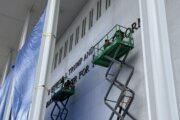Trees and lawns love leaves, just not whole leaves
Beth in Columbia, Maryland, has some great questions about leaves! She writes: “I’ve been reading that trees need the leaves to remain at their base for enriching their growth. Is this true? Do you need to put them on top of newspaper or cardboard? Must they be shredded? I know not to put them up against the tree trunk.”
Yes, Beth; thanks to deep roots that reach fresh nutrients every season and the magic of photosynthesis, leaves do feed the trees that dropped them. It’s why forests don’t need to be fed; they’ve evolved into the perfect sustainable system.
No; you don’t need, or want, cardboard or anything else down there. You want the roots of the tree to be able to breathe and receive rainwater unimpeded.
And yes, the leaves must be shredded.
In nature, dropped leaves smother the smaller plants near trees, which is fine in the forest, but not in a home landscape where those leaves mat down, make a mess and can smother things you maybe wanted alive, such as spring bulbs and herbaceous perennials. Shredding the leaves with a lawn mower or a leaf blower set on reverse turns them into a breathable mulch that slowly feeds your trees and other plantings without causing problems.
Can this year’s leaves be used right away?
Beth continues: “Your previous plots advise shredding leaves and saving them for next spring, as opposed to using them right away. Wouldn’t it help the garden to keep the leaves in place over the winter?”
Yes and no, Beth.
Mowing leaves into your lawn as they fall is a great way to boost the health of your turf and prevent or eliminate thatch at the soil line. Mulching your garden beds with shredded leaves is a great way to prevent erosion and nutrient loss and protect the roots of perennials.
But shredded they must be.
As we can’t stress too often, trees “use” their leaves to smother low-growing competition and leaving whole leaves in place can injure a lawn and severely stress small plants. Shredding them unleashes their benefits and negates their negatives.
But please save some of those shredded leaves for making compost and mid- season mulching.
Winter’s the perfect time to tame tall trees
Joe in Rockville writes: “We have two ginormous tulip poplars in the backyard, which were mature when the house was purchased 28 years ago. We’d like to allow more afternoon sun into the yard. Should we have any concerns about having a reputable tree service prune them in late winter/early spring to allow more sunlight to pass through?”
Not at all, Joe. Although the job will be expensive, it’s an excellent idea and the dead of winter is the perfect time to do so: The arborists can do their best thinning work when they can see the bare bones of the tree. And while they’re up there, they can easily spot and remove the dangerous dead branches that always seem to adorn the tops of tulip poplars as they age.
Hide the pruners until May
Joe in Rockville has just saved the lives of many precious plants! He writes: “Should the trimming of overgrown azaleas wait until late winter/early spring? Or could they be trimmed back now?”
Neither, Joe. (Or is that “nither”?) Either way, don’t do it!
First, no plant should be pruned now, as they are entering dormancy, and waking them up with an ill-timed haircut can greatly sap their strength and invite winter injury.
And spring bloomers such as azaleas, rhododendrons and lilacs have already formed next year’s flower buds. Their rule is the easiest of all plants to remember: Only prune plants that bloom in the spring right after they finish blooming in the spring. Pruning in summer, fall or winter can remove flower buds and destroy their springtime show.
You can prune away as much as a third of the plant after the flowers have faded. If they need more than that, spread the work out over several seasons.
Don’t position piles on your lawn
Tom, in “Virginia’s western suburbs,” writes: “This is my first year composting leaves, shredded as per your advice. But I am running out of places to put my piles because of the number of bags of leaves put out for curbside pickup that I’ve ‘stolen.’ Would composting some of the shredded leaves on a grassy area of the back yard kill the grass underneath?”
Oh yes, it would be a bad thing, Tom.
As people who have had mulch delivered learn quickly, anything that smothers the grass can, well, smother the grass! If all of your non-lawn area is filled up, just shred, re-bag and store those “rescued” leaves until the spring. (Shredding them now will reduce their volume so you’ll be able to fit 10 bags of previously whole leaves into a single bag.)
Or empty a few bags onto your lawn and mow them in. Lawns like those kinds of leaves.
Follow @WTOPLiving and @WTOP on Twitter.







